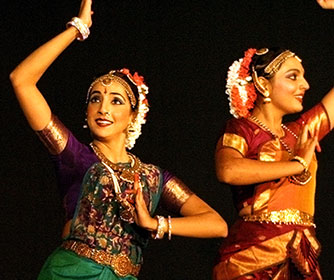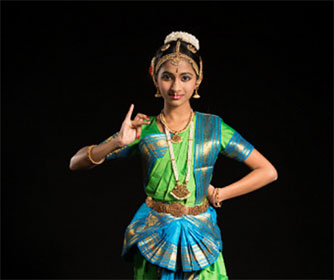UTSA researcher wants to use classical Indian dance to teach schoolchildren geometry

Research aims to provide Asian Indian-American children opportunities to connect education and culture

Gowri Iyengar (Photo courtesy of Kalpana Iyengar)

Research aims to provide Asian Indian-American children opportunities to connect education and culture

Gowri Iyengar (Photo courtesy of Kalpana Iyengar)
(March 31, 2016) -- Kalpana Iyengar, a lecturer with the UTSA Department of Interdisciplinary Learning and Teaching and researcher with the San Antonio Writing Project (SAWP), explores the use of classic Indian dance to teach geometry and other math concepts to Asian Indian-American schoolchildren in a recent study published in the Journal of Fine and Art Studio.
“For so long, dance has been regarded as solely an aesthetic experience, an entertaining work of art,” Iyengar said. “But history demonstrates that dance can be useful beyond that. In this case, I wanted to see how culturally relevant dance could help Asian Indian students better grasp basic shapes and learn concepts common to both mathematics and dance.”
Iyengar studied the idea using classical Indian dance known as Bharatanatyam, which is often characterized by its use of stylized, schematic body movements and sculpture-like poses. Bharatanatyam dancers use poses and movement to convey ancient Indian stories from the Hindu epics Ramayana and Mahabharata.
In recent years, Bharatanatyam has become popular among Asian Indian-American families as a medium for children to connect to their cultural heritage and roots. Iyengar was inspired to pursue the research after watching her daughterGowri practice Bharatanatyam at a local performing arts center.
“Bharatanatyam dancers often create basic geometric shapes – like the line, square, rectangle or triangle – with their bodies to tell their stories,” Iyengar said. “After all, these basic shapes have long been how we visually represent the world around us. The repetition of these shapes helps cement the elements of geometry in our minds.”
Over the course of a few months, Iyengar worked with Asian Indian-American students of various school ages in three major cities in the Southwestern U.S. Some students had first-hand knowledge of Bharatanatyam; others had none. Each participant was shown Bharatanatyam performances, such as Savitha Shastry’s “Bharatanatyam Jathi,” and instructed to answer several questions relating to geometry, their experience and the performances themselves.
“I found that students were more readily comprehending the lessons when they learned them through a lens that is familiar and contextual to their home cultures,” Iyengar said. “The cultural aspect of this dance meant that they were more likely to be engaged and thus be more receptive to the lessons.”
Iyengar found that the children were drawn to the Bharatanatyam performances and were eager to name the shapes they saw during the performance. According to her, the older students more easily connected the commonalities between the mathematics concepts and the dances.
“I would like to conduct a similar study with a larger and more demographically diverse student population,” Iyengar said. “I also want to see whether this trend of student engagement is observable in other Western dance styles, such as ballet and hip hop.”
Iyengar has long been motivated to find new ways for Asian Indian-American children to engage with their culture in the classroom. She adds that curriculums in schools do not often find ways to connect Asian Indian students’ heritage to their studies, and there is a dearth of research into Asian Indian-American students and their learning habits in the classroom.
“I believe that, as educators in an increasingly multicultural society, it is important that we provide diverse students with opportunities to engage with their cultures and heritage,” Iyengar said. “The effects of such approaches can only be positive and beneficial to children’s psychological well-being.”
Iyengar is the founder and co-director of the Kahani Project, an annual event that SAWP hosts with the India Association of San Antonio. Now in its ninth year, the Kahani Project is designed to give Asian Indian students, aged from elementary to high school, an opportunity to write about their cultural heritage in public spaces. In 2015, she and faculty with COEHD helped create an affiliate of the San Antonio Writing Project in India titled the Haridwar Writing Porject.
By Jesus Chavez
Public Affairs Specialist
----------------------------
“Bharatanatyam and Mathematics: Teaching Geometry Through Dance” was published in the Journal of Fine and Studio Art, Vol. 5(2) pp. 6-17.
Learn more about the UTSA College of Education and Human Development.
Connect online at Facebook, Twitter, YouTube, Instagram and UTSA Today.
Events
The UTSA Office of Undergraduate is proud to celebrate National Undergraduate Research with an annual event sponsored by the (OUR) featuring students will showcase undergraduate student research and creative endeavors from all disciplines across campus.
Various LocationsDía en la Sombrilla, formerly Fiesta UTSA, is a festival hosted each spring as a part of Fiesta® San Antonio events. Sponsored by Roadrunner Productions, the event features music, food, confetti, games, event t-shirts, and more.
Sombrilla Plaza and Central Plaza, Main CampusFiesta Arts Fair features contemporary art from more than 100 artists from across the U.S., Fiesta favorite foods, drinks, live music by local and regional performers, and a Young Artists Garden providing opportunities for budding artists to learn, explore and express their creativity.
UTSA Southwest CampusJoin the PEACE Center and Wellbeing Services for Denim Day, a day of learning about the importance of consent and why we wear denim on the last Wednesday of the month each April during Sexual Assault Awareness Month. Stop by our Denim Day display to take a photo in front of our Denim Wall, spin the "Is It Consent?" Wheel, and get a Concha or goodie.
Student Union Window Lounge, Main CampusLearn to use Zotero®, a citation manager that can help you store and organize citations you find during your research. Zotero can generate bibliographies in various styles, insert in-text citations and allow you to share sources with collaborators.
Virtual EventThis event is to achnowlege the graduating seniors and induct the new cohart of scholars to our program.
North Paseo Building (NPB 5.140,) Main CampusCelebrate the accomplishments of College of Education and Human Development, College for Health, Community and Policy, College of Sciences and University College.
Alamodome

